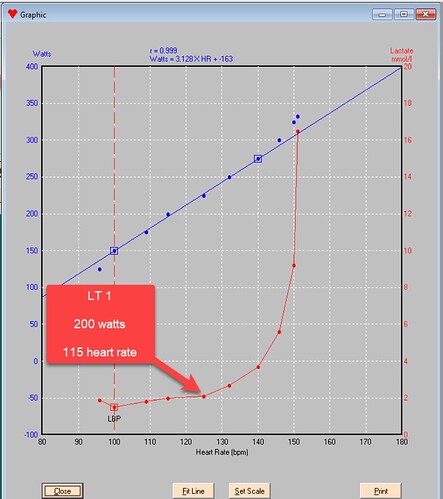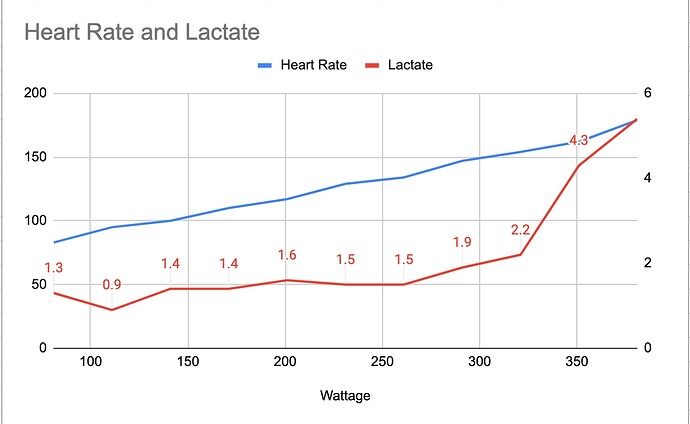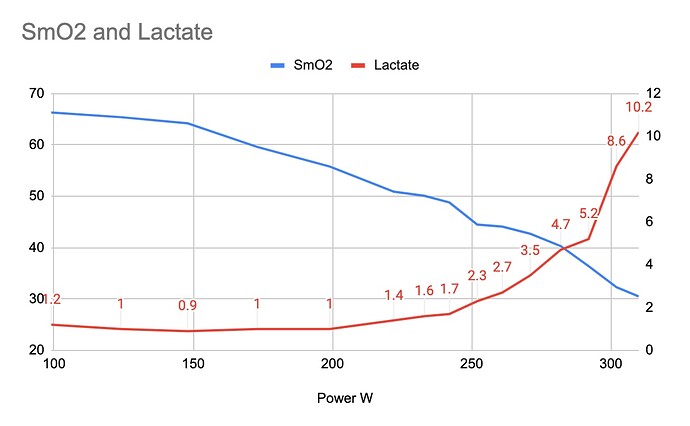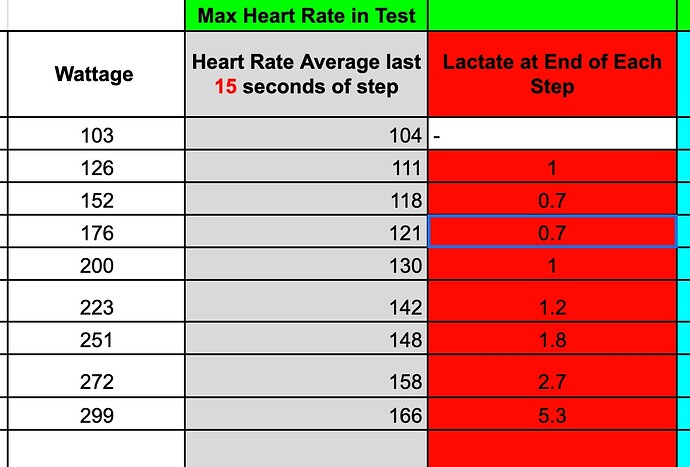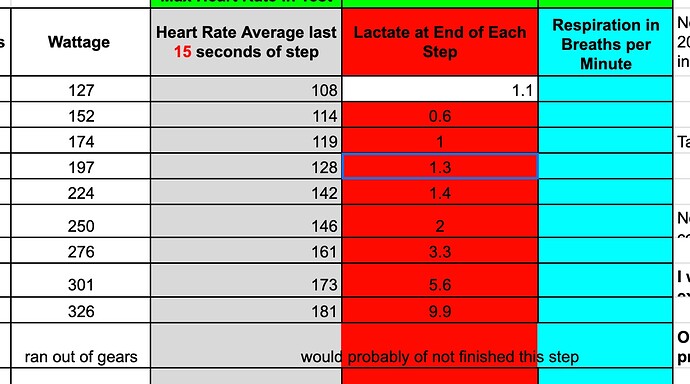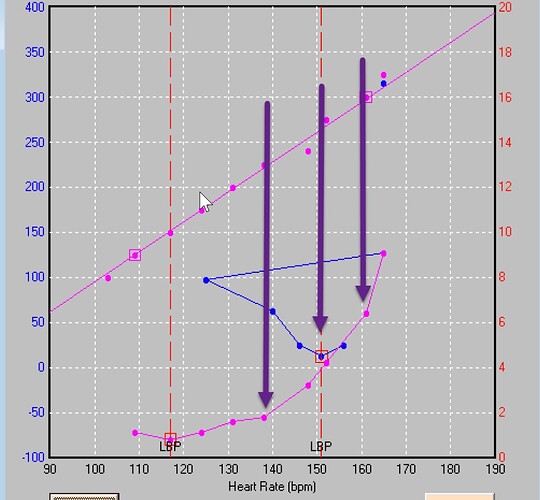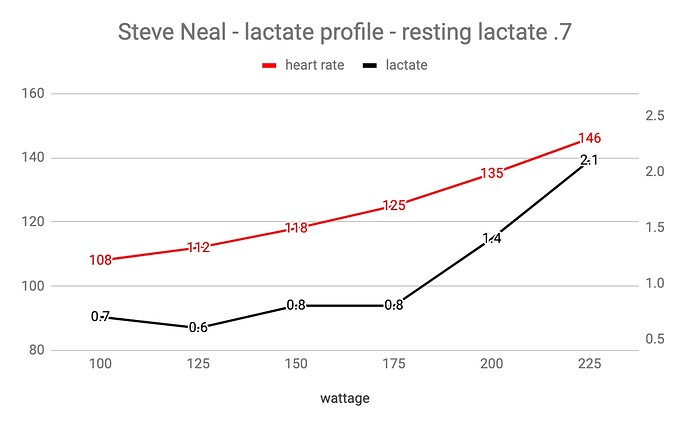@Fpike thanks, maybe it is pretty simple.
northk,
It really is that simple. Too often we all make training more complicated vs what it needs to be. Sure there are sport specific, event specific etc training that can certainly help but at the end of the day training is all about sending a signal to the body and consistency is KING!
This is why I like the poliarized approach for many athletes. It is simple: ride easy like your mother is with you on the easy days and ride hard like your life depends on it in the hard days. In 8-12 weeks you will start to see the improvement in economy, sustained power, VO2. You will become more durable and be able to ride more if you want as you are doing so many easy rides the frequency of rest days and regeneration weeks can be minimized as well. Good luck and happy training.
I would say that is a very atypical lactate curve and would question what the athlete was doing in the minutes prior to the test (and his or her profession) - but it could also illustrate perhaps the most important point of this thread: Training zones (and lactate levels) vary significantly from athlete to athlete!
I agree than many of the things that we measure are individual, but many are similar.
He is the head respiratory doctor at a major hospital.
He is 44.
He had done 1 hour of easy endurance the two days prior, no shifts at work. No kids.
He drove 30m to the location of my test facility, not in traffic, no stress.
minutes prior, resting for 20m while I setup equipment. 10m at 100w to calibrate trainer, then start test.
Here are a number of other profiles.
I am confused, and hope you can clear something up for me. You suggested that the easy rides, following the polarized model, be less than 80% of HR max, around 80% of the riding time, and that 20% of riding be at 90% plus.
The 80% HR max is what I was told my top end endurance zone ride would be. Yet I read in other posts in this topic suggesting that the HR max for the slow, 80% ride time be much slower. And I think Dr. Seiler spoke about 70% or so, depending on fitness.
I prefer to ride at 80% HR max for endurance rides; your post reinforces what I have been riding at, but why do I see others, perhaps Dr. Seiler himself, use lower HR max numbers for the longer, slow endurance rides?
micomico,
80% or less of max HR is what I have heard Dr Seiler say, in fact it was noted as such on his recent polarized deep dive right here on FastTalk Labs. While it does and can vary between athletes based on thier unique physiology, fitness and durability I feel comforatble with 80%, that said I like 72% or less on those easy days for athletes that I coach that have a hard time going easy. I lower the cieling in order to be sure they are going easy on those easy days. The whole point with polarized is either easy or hard and most have trouble with the easy, thus the 70 or 72% or less of max HR. You could also define even more and say less than 2hrs at 80% or less maxHR and over 2hrs espcially those big booster rides of 4+hrs down to 70% or less. It is the “moderate” intensity and strain of 80-86% of MaxHR that you want to avoid. To clarity as well 80%/20% of riding is sessions or individual rides NOT total riding time. For example, if you ride 5x week then 1 ride would be the HIIT of your choice (4x4, classic 4x8 or even 4x16) all other rides are easy.
Hope this clarifies for you. Keep it simple and you will get results!!
It does, that helps a lot, thanks. As well as the advice on 70% or less on the longer rides. I think that is where I may be dropping the proverbial ball; on 3.5 hours rides, I am still closer to the 80% when I am pedaling.
I live in a hilly part, and 70% on a climb is just…but I get it.
Do you suggest for those of us that climb, and then have freewheeling minutes going down the mountain/hills, to compensate for the non-effort times, to ride with a little higher HR rate than one a flat, steady ride?
Also, the days in the winter when I must ride on the trainer, I have heard that 1 hour of endurance ride, with non-stop steady pedaling, is the rough equivalent of 1.5 hours of endurance riding in the streets/hills/mountains.
Is that true? I know that slightly different muscles are used, and usually slightly lower power output on the trainer.
Thanks for your comments on mine and other posts, it helps!
micomico,
This is where discipline comes in and many often get it wrong with poliarized, by definition polarized is exteme opposites and you really need to monitor the time at 80-87% max HR so in stead of coasting down the hills which will only affect yor average HR not time spent at 80% or lower or the disitriubution of HR buckets you may want to look at alternative routes or having to ride inside on easy days? Using your gears and staying in a really low easy pedaling gear can often keep intensity in check- you MUST learn and be OK with how slow you will be going uphill, but it can happen, depending on % grade of the hill of course.
Indoor vs outdoor riding is getting alot more attention, advanced software like WKO seperates indoor and outdoor FTPs as well as training zones, even a chart that overlays power curve of indoor vs outdoor. I too have read articles about how 1hr of indoor riding is equal to 90M of outdoor riding as far as the training load is concerned. I do coach this way and tell athletes that indoor rides are worth a little more vs outdoor with the constant resistance under you and it is so “pure”. I think the 2 biggest things you can do for yourself for indoor riding is acknowledge you power productiuon is often about 10-15w lower indoors whcih means your FTP and training zones need to be adjsuted according., otherwise you can be traiing the wrong energy system alltogeher and that is not productive training. I have my athletes do seperate basleine tetsing once indoor season arrives for them so we are accurate out of the gate. The other piece to indoor riding is ERG mode. While some rides are ok in ERG mode, I prefer more rides in non erg mode to help the athlete derive power under thier own vs having ERG mode help them. I have seen athletes come to me after “winter indoor” training and hire me as a coach for the srping and summer and after riding ERG mode all winter they cannot produce same power they did indoors, so be careful just how much time you spend in ERG mode.
Happy Training!
Great stuff, thanks!!
Sometimes you just have to have a mind shift in that you need to learn to go stupid slow in ordeer to go freakishly fast. When you look at what easy rides actually do for your physiology it is pretty easy to get your hear around why you need to go easy and how critical it is so when you have to go fast you can:
PURPOSE: Enhances aerobic fitness by stimulating greater mitochondrial biogenesis (production of mitochondria - the power house of the cell), enhanced capillarization in the muscles, development of slow-twitch muscles fibres and trains body to more efficiently use fat as primary fuel source. Ultimately, these endurance rides contribute to improved aerobic capacity, lactate threshold and muscular endurance, and reduced VLamax (maximal lactate building rate).
You can read more about the importance of low-intensity training such as this in this great article by Stephen Seiler and Espen Tønnessen:
https://sportsci.org/2009/ss.htm
Thanks, I read the article, long but very informative. I also took your advice to heart and yesterday’s 3.5 hour endurance ride was done with an average 4 beats lower than usual. It was on a fairly flat area, but I most enjoy climbing.
I read that some pros use an ebike for recovery rides, so as not to push it. I went to a local Trek dealer to see about the new domane + with the TQ motors, which are supposed to a big improvement from before. Those will take a few months to arrive.
Can you integrate the following: my zone 1 of 3, for endurance riding, has been set as 126-134 HR.
The 134 corresponds to 80% of HR max. The 126 to 75% HR.
You said that for longer endurance rides, 4 hours and up, to ride at 70% or less of HR. That would be, for me, 117 HR.
That’s a full 9 beats less than my calculated 126 HR minimum Zone 1 HR, which sounds strikingly low.
micomico,
Glad you enjoyed the article! On the HR numbers be sure you are not mixing up traditional 6-7 zone HR based off THR (threshold heart rate), where as the 3 zone or polarized is based off max HR- this could be the diff in numbers.
Indeed some of the easier rides will seem very easy, this means you are executing them correctly! Trust me, even when you ride at 65-70% of max HR for longht enough you will experince cardiac drift which is also a main metric to look at and impove on long easy rides. Again, do not hung up on such details of % of MAXHR on the easy rides, just be sure to ALWAYS keep the easy rides under 80% MaxHR and DO NOT get in habit of riding at that cieling lest you add fatigue you do not want and not necessarily more fitness!
You have cost me a lot of money!
Just kidding, but yesterday afternoon, after reflecting more on your posts and others, I swallowed hard and put a deposit for a Domane + SLR 6, a very expensive Xmas gift of sorts.
I did so because in looking at my endurance rides in the mountains, in doing 3-4 hour rides, I ride toward the high end of my zone 1 of 3, and going slow enough to ride around 70% of HR max on long climbs is simply not a pleasure.
RPE does not work well for me in endurance rides. At 75% HR after 3 hours I still feel quite good, but I see the Power/HR come down as I decouple. I wish Garmin and others came out with a real-time decoupling number as one of their many available metrics, instead of waiting to check TrainingPeaks post-ride.
Merry Xmas!
Lol. Merry Christmas to you as well! I’m glad I could help you decide on that new bike  . Keep me posted on how your training is going!
. Keep me posted on how your training is going!
yep, maybe someone can suggest some training wheels for me the minute I hit a hill at my even lower HR, so I won’t fall of the bike 
I do what I call the alphabet test during my easy rides.
When sat on your sofa like when browsing this post. Recite the alphabet and see what letter you get to before needing a breath. Don’t try to resist taking a breath, just take it when it feels like you need to. Make a note of what letter you reach. When out on an easy ride repeat the test and see what letter you can get to whilst needing a breath. If you are just a couple of letters short than when resting likely about right, more letters short and likely working too hard.
If you do the test when at a steady heart rate, you’ll get to calibrate the test to heart rate. But as others have stated , your upper limit will vary by ride. So just do the alphabet test nice warmed up and at a steady heart rate to recalibrate and away you go. Then repeat the test every so often as you fatigue to decide if it’s time to end the ride and head home.
I generally end up riding between 60-70% of max HR on the flat and downhill, on uphills I try and stay within that with an absolute cap of 75%.
On uphills keep an eye on how fast your heart rate is climbing and back off early if it looks like you’re going to overshoot your easy range. Doing the alphabet test as you ascend the hill can help keep you in check.
Good luck, you’ll get a lot of benefit from the easier longer rides.
Thanks, I tried it yesterday. Likely I have to do a few more times to get it right. I was on the same letter in the first as well as fourth hour of a 4 hr endurance ride. At 68% of HR Max average, and pretty much kept it there even climbing. The descents were gentle enough I could still pedal.
So it seems, unless I am doing it wrong, that at those HR levels, I don’t feel it cardiovascularly, at least not via the breath. But my legs were tired from the start, and I decoupled early and by the fourth hour my watts to same HR had dropped a lot, so my legs were definitely feeling it. I likely rode too much prior to this ride.
The more aerobically fit you get the longer you can go before decoupling assuming you are hydrating and fueling sufficiently.
Maybe next time go out and find at what steady heart rate you start to need to take a breath an an earlier letter. Start to find that point where your breathing changes from rest.
I did a 3 hour 20 min easy ride today, aerobic decoupling 1.84%. It just takes time to get there as you increase the duration. I’ll be riding 4.5 hours easy in a couple of weeks and I’ll see what decoupling occurs then.
Funny you say that.
I was thinking of creating a Garmin IQ field to do such a thing.
Something along the lines of
- Parameter to set warm up period, default 20 mins or something.
- Duration of period to be measured to set baseline.
- Keep track of a rolling average power / HR ratio equal to the duration defined in part 2.
Thus ignores warm up period. Then calculates baseline over duration set in 2. Then starts reporting decoupling on a rolling basis compared to baseline.
I’ll likely have a play in Jan once I’ve refreshed on the definition as I think the power is defined as percentage of 6 min power or something.
